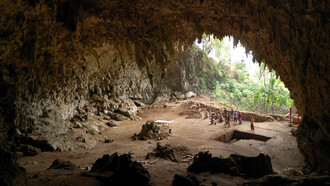On September 18, 2018, Cristina Fernández de Kirchner recorded a video after her house in El Calafate (in southern Argentina) was raided. In it, she denounced that, among other things, two paintings by Nora Patrich and Mario Mollari—two artists from the Espartaco group—had been stolen. The next day, all news portals published articles about this group of artists from the 1960s, who were completely unknown to the general public. At least, they were unknown by name because the works of its members are very present in public spaces.
The Espartaco group or movement was founded in 1959 when Rafael Squirru, director of the Buenos Aires Museum of Modern Art, invited Juan Manuel Sánchez, Ricardo Carpani, and Mario Mollari to exhibit their work at the National Salon of Mar del Plata. That same year, Carlos Sessano and Esperilio Bute joined, and they took the name Grupo Espartaco in homage to Rosa Luxemburg’s Spartacist revolution. Their goal was to revive the tradition of Mexican muralism by depicting Argentine reality.
In 1961, they published their manifesto, which begins by criticizing Argentine art for doing nothing but copying without engaging with its political and social reality. As a result, art “is then reduced to a mere game with plastic elements, an inexpressive virtuosity, in some cases of excellent technique, but in no way art, since art is only possible when the artist completely identifies with the reality of their surroundings.” That same year, Carpani was expelled from the group because, in Bute Sánchez de Hoyo’s words, “he sought to dictate aesthetic standards, accused Bute of being decorative and Mollari of being pseudo-indigenist, but the harshest accusation was branding Carlos Sessano as an infiltrated communist.1” After Carpani’s departure, Pascual de Bianco joined the group.
Like any manifesto, it aimed to create an impact, but what the Espartaco group claimed was not entirely true. Consider, for example, Benito Quinquela Martín and the entire La Boca group, who gained international recognition in the 1920s for painting working-class subjects. We must also consider the youth of its members, who at the time were between 20 and 30 years old and had the audacity that only youth grants. Interestingly, in 1961, Antonio Berni held an exhibition at one of the city's most prestigious galleries (Witcomb) and introduced his character Juanito Laguna, who, in his own words, “is a poor boy but not a pitiable child.” His works were made from discarded materials that Berni himself collected from garbage dumps. Something was already stirring in the national art scene.
The Espartaco group preceded the explosion of the avant-garde at the Di Tella Institute, and the history of its members is marked by the ups and downs of Argentine history. In 1963, Bute left the group, and Franco Venturi joined. In 1976, Venturi was kidnapped by the military dictatorship that took power that year, becoming Argentina’s first disappeared artist. Other members of the group included Nora Patrich, Elena Diz, and Raúl Lara. The latter is particularly interesting due to his Bolivian heritage—a community that is often discriminated against in Argentina. Despite being neighbors, their artistic expressions remain largely unknown to Argentinians, viewed more through an anthropological lens than an artistic one.
In 1968, the Espartaco members reconciled with Carpani and won the elections for the board of the Argentine Society of Plastic Artists. That same year, after a retrospective exhibition at the Witcomb Gallery featuring all its members, the group decided to disband, arguing that their objectives were now aligned with those of the broader artistic community, making it time to take new actions. However, this did not last long, and most of the Espartaco members went into exile in Spain, considering that after the Cordobazo uprising in 1969, Argentina’s political situation would become increasingly repressive.
In 2018, director Ana Caride Burgos released the documentary Ojos bien abiertos… el movimiento Espartaco, which tells the story of all the group's members, featuring interviews with those still alive and exploring both public and private archives. It also documents the recovery of Carlos Sessano’s 1966 piece Los candidatos del pueblo in collaboration with the National University of Tres de Febrero. Caride Burgos’ documentary is striking. It opens with Sessano’s daughter admiring one of her father’s paintings from 1975, hidden away in a small tool shed. The painting features a fragment copied from Picasso’s Guernica, a person being executed, and two children (the artist’s own) staring directly at the viewer with white rectangles over their eyes. Through visits to archives and interviews with former members and relatives, the film weaves together their stories.
Interestingly, it is the children who are now taking up their parents’ legacy to share their work with the world. For example, Bute’s son, Eduardo Bute Sánchez de Hoyos, is an academic who has centered his research on the Espartaco group. As I mentioned earlier, Espartaco’s art is deeply ingrained in Argentina’s visual culture—from Ricardo Carpani’s works in labor union headquarters to the murals Sessano and Sánchez left on various buildings throughout the city.
In 1965, Mollari and Sánchez painted two murals for the new headquarters of the Faculty of Exact and Natural Sciences at the University of Buenos Aires. It was intended to be a triptych, completed by a mural from Sessano above the main lecture hall stage. However, the 1966 military dictatorship disrupted these plans by intervening in universities, and the cycle of violence that followed until 1983 halted the project. It wasn’t until 2019 that Sessano finally completed his mural. Sometimes, art delivers the justice that society cannot.
Notes
1 Bute Sánchez de Hoyo, E. (2012). Apuntes, fuentes y reflexiones estéticas para el estudio del movimiento Espartaco (Argentina 1959-1968). Laboratorio de Arte, 24(2).















